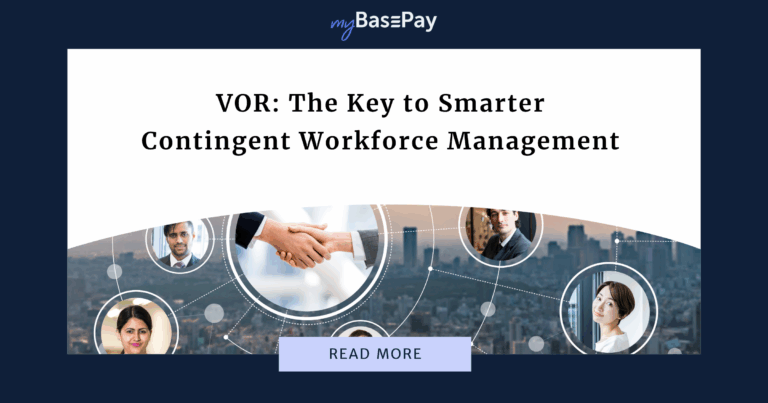The Hidden Risks of Poorly Managed SOW Engagements (and How to Fix Them)
By Amy Reeves, Enterprise Sales Director
Many organizations feel confident in their staff augmentation programs—well-defined processes, clear oversight, and predictable spending. But what about your Statement of Work (SOW) engagements?
SOWs are often intended to offer more structure, control, and flexibility than other contingent workforce models. Ironically, they frequently become hotbeds of mismanagement, hidden costs, and risk exposure when left unchecked, impacting your entire organization, quietly eroding business efficiency and compliance. Some processes can be implemented to regain control without sacrificing agility, letting you maintain the speed and flexibility you need while eliminating the legal, financial, and operational risk.
What Is a Statement of Work (SOW)?
A Statement of Work (SOW) is a formal document that defines the specific services or deliverables a vendor will provide within a defined scope, timeline, and cost. Unlike time-and-materials models used in staff augmentation, SOWs focus on outcomes and results, not hours logged or roles filled.
While SOWs typically list job roles (like “UX Designer” or “Project Manager”) rather than individuals, some engagements, particularly those involving critical expertise or high-profile clients, may name specific personnel. This hybrid model, however, can introduce complexities if not governed well.
Why C-Levels Should Care
Unlike traditional staff augmentation, SOW engagements are often decentralized, inconsistently tracked, and poorly audited. This lack of oversight (rogue or unmanaged spend) can open the door to unplanned, uncontrolled expenses that drain budgets and increase legal and operational risks.
Worker misclassification is one risk that often arises when organizations blur the lines between staff augmentation and SOW because assigning day-to-day tasks under what should be a deliverables-based model introduces risk. This can create significant legal liabilities, particularly when the work resembles that of a W-2 employee rather than a 1099 contractor or service vendor. This can trigger costly audits, penalties, and back-tax obligations that can erode future budgets.
Lack of standardization in SOW engagement can also lead to compliance gaps through inconsistencies in onboarding, background checks, security access, and other governance practices, opening the door to audit failures and regulatory issues. Without properly worded contracts and scopes, organizations may lose control over the IP created by SOW workers or fail to retain the full rights to use the deliverables they’ve paid for.
Finally, SOWs lacking well-defined outcomes, enforceable milestones, or structured oversight can lead to duplicate work and hidden costs that go unnoticed until it’s too late. Scope creep in informal SOW arrangements typically results in 20-40% budget overruns, making budget forecasting and quarterly results unreliable.
Best Practices for Managing SOW Spend
Taking back control starts with thoughtful design, a consistent process, and cultural alignment that requires stringent oversight.
Here are a few considerations:
Define Clear Scope and Deliverables: Avoid vague language. Be precise in what success looks like. Scope creep is the #1 driver of cost overruns.
Standardize Vendor Management: Ensure all vendors go through the same risk review, onboarding, and performance evaluation, regardless of department or project owner. Even if your SOW spend lives in another area from other staff augmentation spend, the risks are reduced while still offering flexibility for the business to engage with trusted partners.
Stay Compliant: Work with legal, HR, and partners to ensure worker classification rules are respected and IP protections are airtight.
Leverage the Experts: Partner with organizations in the industry that have the people, process, and technologies built to enable these best practices.
Why SOW Reform Isn’t Easy
Restructuring how SOWs are managed can meet resistance internally because hiring leaders and departments value autonomy. Change often feels bureaucratic, or there are existing relationships with project-based vendors that have been in place for years. There may be fear of slowing down projects or introducing partners that lack the experience and knowledge of the organization.
The key is to educate stakeholders on the hidden risks and frame reform as enabling better, faster, and safer outcomes. When SOW spend flies under the radar, organizations face consequences far beyond overspending., Agent
BP’s Deepwater Horizon disaster uncovered systemic cost-cutting and oversight failures among contractors, including inadequate oversight, leading to catastrophic environmental and legal fallout, which cost the organization over $19 billion. Carillion’s collapse in the UK serves as a cautionary tale of decentralized project execution, off-balance sheet liabilities, and a lack of visibility into project spend and deliverables, leading to massive implications for suppliers, subcontractors, and retirees.
These are stark reminders that a lack of visibility and control over contract-based work can escalate into strategic, financial, and reputational implosions.
How We Help Organizations Reign in SOW Risk
myBasePay addresses these issues head-on by acting as a modern Employer of Record (EOR), Agent of Record (AOR), and compliance partner integrated into your SOW and contingent workforce ecosystems. We do this through the management of:
Worker Misclassification: We assume responsibility for W-2, 1099, and subcontractor classification, reducing misclassification liability and streamlining compliance.
Compliance Gaps: Our platform provides end-to-end onboarding, background screening, payroll, and local regulatory compliance across jurisdictions.
IP Safeguards: Our managed contracts include enforceable IP assignment clauses and outcomes-based SOW structures standard across our boilerplate.
Budget and Oversight: Our solution incorporates milestone tracking, standardized SOW templates, and integrated reporting to flag scope creep and overspending.
By layering these controls into your SOW process, myBasePay enables flexibility without sacrificing governance or transparency, turning potential SOW pitfalls into streamlined compliance and efficiencies at scale.
Let’s start a conversation.

